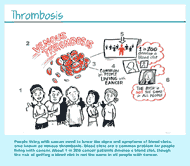Causes & Risk Factors
The risk of VTE is increased when blood flow is impaired, when veins are damaged or if a medical or surgical condition is triggering blood clotting. When one or more of these conditions occur, thrombosis (excessive clotting) can start. Thrombosis can be caused by:
Previous blood clots |
Infection or chronic inflammation |
Long periods of immobility |
Cancer |
Recent surgery, injury or trauma |
Heart failure or chronic lung problems |
Being overweight |
Some immune disorders (eg. Lupus) |
Recent hospitalizations |
Central venous indwelling catheters (eg. Ports, PICC lines) |
It can be difficult to identify the specific cause of deep vein thrombosis. The term “unprovoked” DVT is used to when the cause of blood clotting is unknown.
Healthy people are also at risk of DVT or PE. Those at risk include:
- People over the age of 65
- Women who are pregnant or have recently given birth
- Women taking birth control pills
- Women taking hormone replacement therapy
- People with a family history of blood clots
- People with inherited clotting tendency
Regardless of the cause DVT and PE require immediate diagnosis and treatment.
Important facts about Thrombosis
- DVT or PE can develop in an otherwise healthy person
- Only half of people who have a thrombosis experience any signs or symptoms
- Symptoms may be present in one or both of the calves, the knees, the thighs, the groin area or the chest
- Thrombosis symptoms can change: be aware of changes!
- Thrombosis symptoms can take several weeks to resolve after treatment has started

To view a 5 minute video on Cancer and VTE, click above.

